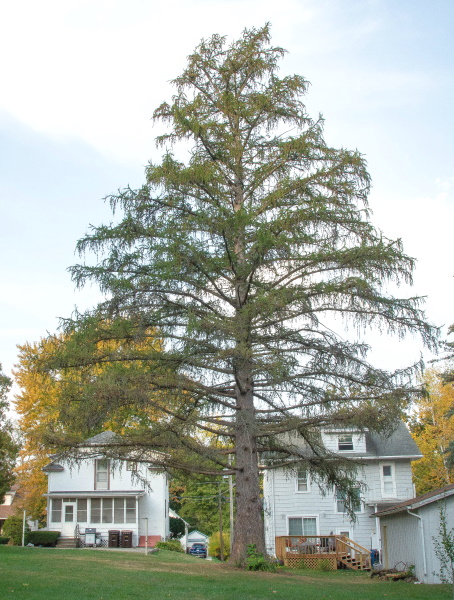A European Larch (Larix decidua) is deeply connected to a family and a neighborhood in Freeport, IL. This special tree is being recognized as Natural Land Institute’s Legacy Tree Program November Tree of the Month, because of its history and size. The height is 105 feet. It has an average crown spread of 45 feet and circumference of 137 inches.

This European Larch was nominated by the son of the young boy who planted it around 1930 and who was seven at the time. The Larch grown in a nursery on Wise Avenue, adjacent to Dale A. LeBaron’s home. Dale helped water plants at the nursery; he received the tree as a gift from the owner, John Wise. The young boy, was about the same size as Dale when he planted it in his backyard.
With such a personal and deep connection to the Larch, Dale and his wife Carolyn (in the late 1960s or early 1970s), commissioned local artist, Charles McDermott, to create a large water color painting of the tree. The framed painting hung in the LeBarons’ home until their passing.
Dale’s son, Craig, said in the nomination that his dad passed away in 1985, while the tree has survived to this day. He estimates the tree to be around 100 years old, calling it a “century tree.” That is because, he thinks it was the same age as his dad when it was planted, and his dad would have been 100 in September 2023.
Craig said, “I remember climbing this tree to see how high I could go. I marked the tree limb at the point where the tree could no longer be climbed. Over the years, the mark never changed because the tree didn’t grow as fast as I did. Growing up, my aunt and uncle lived at this location along with my cousins. The neighborhood had plenty of young kids, and I would guess that I was not the only kid to climb this tree. Larch trees are fabulous trees to climb! Their limbs are well spaced for just such fun.”
Craig’s cousin, Mark LeBaron, became the owner of this property. After a few years of living there he asked Craig to help him build a garage. “We were concerned about the Larch when we severed one of its roots with the backhoe while digging the footing. That was back in the early 1980s, so it appears our worries were unfounded,” said Craig.
Larches are deciduous conifers–yes, not all conifers are evergreens (including bald cypress and dawn redwood.). Larch trees’ soft needles turn lovely shades of yellow late in the fall, usually in November and often as late as Thanksgiving. New needles emerge in the spring, and all larches produce cones similar to spruce trees. The best way to distinguish the various species of Larch found around the northern Hemisphere is by their unique cones.
The three most common Larches seen in landscapes in northern Illinois include the European Larch which is most popular; the Native American Larch, Tamarack, or Hackmatack which is native (though very rare this far south) in remnant bogs; the Japanese Larch with cones that look more like they are comprised rose petals than fish scales.
European Larch is native to the Alps mountain range of central Europe and is very hardy and adaptable to our region. Many winter songbirds eat the seeds extracted from the cones or seeds that have fallen from the cones. The tree was once a popular landscape tree, often planted around farmsteads or historic landscapes but now is never found in nurseries. European Larch’s wood is tough and durable – valuable for boat building and quite flexible when cut into thin strips. Larches can be very long-lived trees, readily living over 300 years.
The current homeowner, where this European Larch lives, gave permission to nominate and recognize this tree. Because it is on private property, an address is not available to the public.
Background and For More Information
Natural Land Institute launched the Legacy Tree Program in January of this year. It includes recognition of one tree a month that may be the largest of its kind, or have historical or cultural significance. Anyone may nominate a tree on private or public land from NLI’s 12 county region.
Other components of the program, a list of the 12 Counties, the online nomination form, and the Tree of the Month since January 2024 can be found at: https://www.naturalland.org/nlis-legacy-tree-program-january or by calling 815-964-6666.